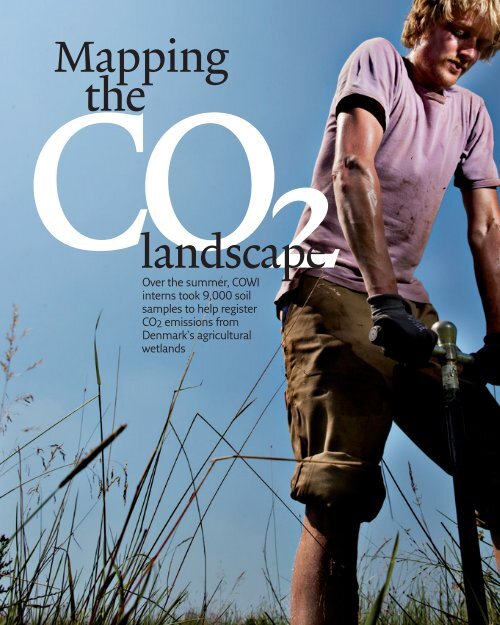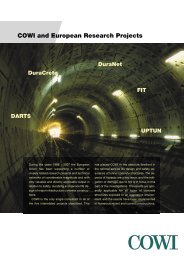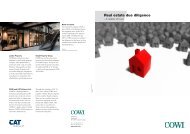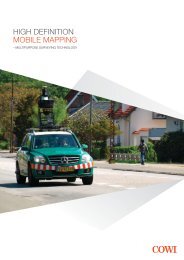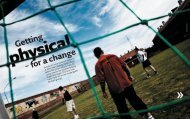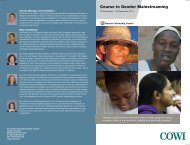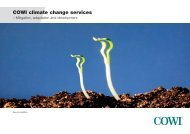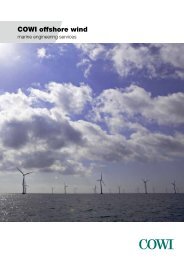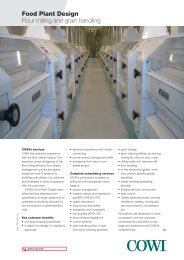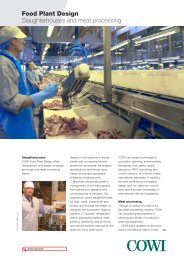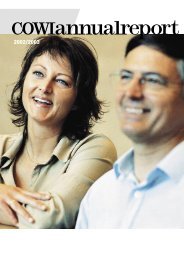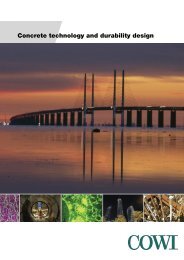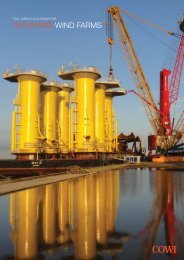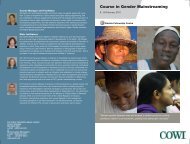You also want an ePaper? Increase the reach of your titles
YUMPU automatically turns print PDFs into web optimized ePapers that Google loves.
<strong>Mapping</strong><br />
<strong>the</strong><br />
CO 2<br />
<strong>landscape</strong><br />
Over <strong>the</strong> summer, COWI<br />
interns took 9,000 soil<br />
samples to help register<br />
CO 2 emissions from<br />
Denmark's agricultural<br />
wetlands
Skagerrak<br />
North<br />
Sea<br />
Sweden<br />
Denmark<br />
River Guden<br />
Kattegat<br />
Copenhagen<br />
Germany<br />
Baltic<br />
Sea<br />
1 The core sampler is loaded onto an all terrain vehicle,<br />
which can make it past even <strong>the</strong> toughest obstacles.<br />
2 Once <strong>the</strong> soil cores are drilled, it takes more hand<br />
power to pull <strong>the</strong>m out of <strong>the</strong> sampler.<br />
3 The cylinder-shaped soil core after it comes out of<br />
<strong>the</strong> sampler.<br />
1 2 3<br />
By Henrik Olsen<br />
The tell-tale drone grows louder as <strong>the</strong> ATV bounces its<br />
way over <strong>the</strong> bumpy terrain along <strong>the</strong> river, zigzagging<br />
between grazing cows. The four-wheeler stops, and <strong>the</strong><br />
driver turns off <strong>the</strong> engine. After ripping off <strong>the</strong> helmet<br />
and shaking out a mane of blonde hair, he scans <strong>the</strong><br />
horizon.<br />
We are standing on <strong>the</strong> banks of <strong>the</strong> River Guden in<br />
eastern Jutland, what many consider to be Denmark’s<br />
most beautiful natural area. With <strong>the</strong> drone of <strong>the</strong><br />
motor gone, <strong>the</strong> larks resume <strong>the</strong>ir song. Meanwhile,<br />
<strong>the</strong> grazing cattle meander closer to inspect <strong>the</strong> fireengine<br />
red ATV.<br />
But it is not <strong>the</strong> lark or <strong>the</strong> view that Nielsen is here<br />
to admire. He and 25 o<strong>the</strong>r cowi interns are spending<br />
<strong>the</strong>ir summer break collecting soil samples from 9,000<br />
locations in agricultural wetlands from all across Denmark.<br />
The samples, being collected for Aarhus University,<br />
will show how much carbon is stored in <strong>the</strong> peat, and<br />
how much <strong>CO2</strong> it releases into <strong>the</strong> atmosphere.<br />
The amount of <strong>CO2</strong> released from peat soils depends<br />
on <strong>the</strong> content of <strong>the</strong> organic materials in <strong>the</strong> ground<br />
and its land use. In order to find out just how much <strong>CO2</strong><br />
<strong>the</strong> peat soils contain, a team of scientists from Aarhus<br />
University has undertaken a project mapping existing<br />
occurrences of peat throughout Denmark. Once <strong>the</strong><br />
team has compared carbon levels with farming methods,<br />
<strong>the</strong>y will be able to come up with a precise calculation of<br />
how much <strong>CO2</strong> is released, as well as ways to cut <strong>CO2</strong><br />
emissions by planting o<strong>the</strong>r crops.<br />
Potato — part of <strong>the</strong> high <strong>CO2</strong> diet<br />
“If you want to get <strong>the</strong> most out of our mapping, one<br />
example would be to stop planting potatoes in peaty<br />
soil. Potatoes have an effect deep down in <strong>the</strong> soil, and<br />
you till <strong>the</strong> soil more than just once,” says Mogens H.<br />
Greve, who is leading <strong>the</strong> study for Aarhus University.<br />
When <strong>the</strong> peat is tilled, large quantities of oxygen<br />
make <strong>the</strong>ir way into <strong>the</strong> soil. The oxygen mineralises<br />
<strong>the</strong> organic material producing <strong>CO2</strong> which is released<br />
into <strong>the</strong> atmosphere contributing to climate change. If<br />
farmers switched from potatoes to grass or grains, <strong>the</strong><br />
negative effect on <strong>the</strong> climate would be reduced.<br />
The results of <strong>the</strong> study will be included in <strong>the</strong><br />
national <strong>CO2</strong> account, which will be used to show<br />
COWI intern Kristoffer Nielsen collects soil<br />
samples from around Denmark using<br />
hand-powered core samplers. Photos:<br />
Niels Åge Skovbo<br />
International news magazine from cowi • 13
4 Drill site locations are measured precisely using<br />
GPS units.<br />
5 Soil make-up, lime content and pH value are measured<br />
before <strong>the</strong> sample is packed for shipping to <strong>the</strong> lab<br />
where <strong>the</strong> organic content will be measured.<br />
6 Yellow stakes mark <strong>the</strong> spot where <strong>the</strong> sample was<br />
taken.<br />
4 5 6<br />
whe<strong>the</strong>r <strong>the</strong> country is meeting its Kyoto obligations. By<br />
2012, Denmark needs to cut its emissions by 21 per cent<br />
on 1990 levels. The current mapping programme will<br />
probably show that <strong>the</strong> country is closer to meeting its<br />
goals than previously thought.<br />
But Denmark is not <strong>the</strong> only country that could<br />
benefit from such a study. Even though mapping is<br />
expensive, <strong>the</strong> financial benefits could far outstrip <strong>the</strong><br />
costs. If <strong>the</strong> study can document a reduction in <strong>CO2</strong><br />
emissions from farmlands, it means fewer <strong>CO2</strong> quotas<br />
need to be bought in order to live up to Kyoto Protocol<br />
obligations.<br />
“Documenting that we can save EUR 200 million on<br />
quotas by spending EUR 9 million on <strong>the</strong> project is <strong>the</strong><br />
kind of return on investment we like,” Greve says.<br />
Three more samples<br />
Back on <strong>the</strong> banks of <strong>the</strong> River Guden, Nielsen packs his<br />
drilling equipment and hammers a little yellow stake<br />
into <strong>the</strong> ground in order to mark <strong>the</strong> spot where he sampled.<br />
The ATV roars to life, and its drone drowns out <strong>the</strong><br />
larks as it speeds off towards <strong>the</strong> horizon. It has gotten<br />
late, and <strong>the</strong>re are still three more locations to sample<br />
today.<br />
@ Kerim Martinez, Project<br />
Manager, kemr@cowi.com<br />
@ Mogens<br />
H. Greve, Research<br />
Unit Head, Aarhus University,<br />
mogensh.greve@djf.au.dk<br />
When peat is ploughed, oxygen<br />
(O2) penetrates deep into <strong>the</strong> soil,<br />
causing organic material to<br />
decompose and release <strong>CO2</strong>.<br />
Illustration: COWI<br />
14 • International news magazine from cowi


